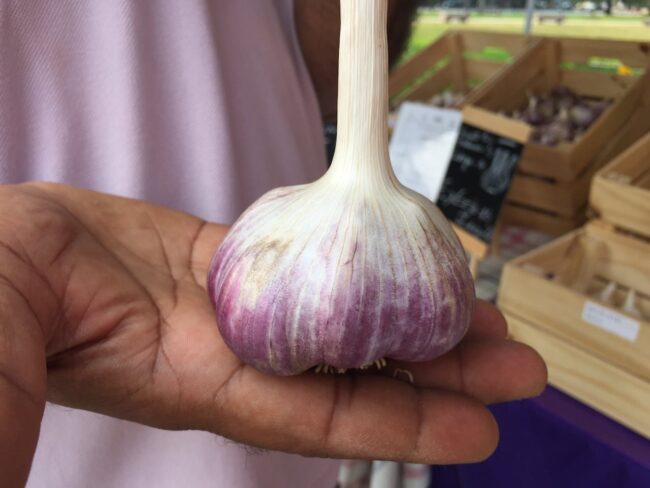Russian garlic is renowned for its high price, but have you ever wondered why it commands such a hefty price tag? The answer lies in its unique qualities and the meticulous care involved in its cultivation. Russian garlic possesses a distinct flavor profile, with a potent and intense taste that sets it apart from other varieties. Its scarcity and demand also play a significant role in driving up its price.
So, if you’ve ever asked yourself, “Why is Russian garlic so expensive?” let’s delve into the factors that make it a gourmet delicacy worth every penny.
Why is Russian Garlic So Expensive?
Garlic, a staple ingredient in many cuisines around the world, comes in various varieties and origins. One type that often stands out for its price is Russian garlic. Russian garlic tends to be more expensive compared to other types of garlic due to several factors, including its unique characteristics, cultivation methods, and market demand.
In this article, we will delve into the reasons behind the higher price tag on Russian garlic and explore its appeal for culinary enthusiasts and health-conscious individuals alike.
The Unique Characteristics of Russian Garlic
Russian garlic, also known as Russian red garlic or Russian Giant garlic, is distinct from other types of garlic in terms of its appearance, flavor, and size.
Here are some key features that contribute to its uniqueness:
1. Bulb Size:
One of the distinguishing characteristics of Russian garlic is its impressive bulb size. The bulbs can be significantly larger than those of other garlic varieties, making them visually appealing and a favorite among chefs.
2. Clove Count:
Russian garlic typically has fewer cloves per bulb compared to other varieties. While most garlic bulbs contain multiple cloves, Russian garlic often has only a few large cloves, which can be easier to peel and handle in the kitchen.
3. Flavor Profile:
Russian garlic is known for its robust and pungent flavor. Its taste can range from mildly sweet to intensely spicy, adding depth and complexity to dishes. This powerful flavor makes Russian garlic highly sought after by culinary enthusiasts.
4. Shelf Life:
Another notable characteristic of Russian garlic is its relatively long shelf life. The bulbs can stay fresh for several months when stored properly, allowing consumers to enjoy the flavor and health benefits of this garlic variety for an extended period.
Read More: About How To Get Rid Of Gnats In Indoor Plants?
Cultivation Methods and Challenges
The cultivation methods employed for Russian garlic play a significant role in its higher cost. Here are a few factors that contribute to the expenses associated with growing Russian garlic:
1. Climate Requirements:
Russian garlic requires specific climatic conditions to thrive. It is typically grown in colder regions with long winters, such as Russia, Ukraine, and other parts of Eastern Europe. These regions offer the ideal combination of cold temperatures, snow cover, and well-drained soil, which contribute to the garlic’s unique flavor and size.
However, creating and maintaining such conditions can be costly for farmers outside of these natural growing regions.
2. Growing Season:
Russian garlic has a longer growing season compared to other garlic varieties. It requires an extended period of cold temperatures in order to develop properly. The longer growing season, combined with the additional time needed for garlic to mature, increases the cost of production.
3. Labor Intensive:
Cultivating Russian garlic can be labor-intensive due to several factors. The large bulb size requires more effort during planting and harvesting, as well as extra care during storage and handling.
Additionally, the unique climate conditions required for successful cultivation may necessitate additional steps, such as providing insulation or protecting the plants from harsh weather.
4. Limited Supply:
Unlike other garlic varieties that are widely grown around the world, the production of Russian garlic is limited to specific regions.
This limited supply creates a higher demand and subsequently increases the price of Russian garlic in the market.
Health Benefits and Culinary Appeal
The higher price tag on Russian garlic is also influenced by its health benefits and culinary appeal. Here are some reasons why people are willing to pay a premium for this particular variety:
1. Allicin Content:
Allicin, a sulfur compound found in garlic, is known for its potential health benefits, including immune system support and cardiovascular health.
Russian garlic is believed to have higher allicin content compared to other varieties, making it a popular choice among health-conscious individuals.
2. Culinary Versatility:
Russian garlic’s bold flavor and large cloves make it a favorite ingredient among chefs and home cooks alike.
Its intense taste can enhance various dishes, from classic pasta sauces to marinades and soups. The unique flavor profile of Russian garlic adds a distinctive touch to culinary creations.
3. Gourmet Appeal:
Due to its large bulb size and unique characteristics, Russian garlic is often associated with gourmet cooking and high-end culinary experiences.
Its visual appeal and powerful flavor make it a coveted ingredient in fine dining establishments, contributing to its higher price point.
4. Specialty Market Demand:
Russian garlic has gained a dedicated following among garlic connoisseurs and those who appreciate unique, high-quality ingredients.
This niche market demand for Russian garlic drives up its price as suppliers cater to this specific audience.
Russian garlic’s higher price can be attributed to its unique characteristics, cultivation methods, and market demand. The large bulb size, robust flavor profile, and longer shelf life make Russian garlic stand out among other garlic varieties. The costs associated with creating the required climatic conditions, labor-intensive cultivation, and limited supply contribute to the overall expense.
Additionally, the health benefits, culinary versatility, and gourmet appeal of Russian garlic fuel its desirability among cooking enthusiasts and health-conscious individuals. Despite its higher price tag, Russian garlic continues to attract those who seek a premium garlic experience that adds a flavorful punch to their meals.
Read More: About Turning A Flower Bed Into A Vegetable Garden
Frequently Asked Questions (FAQs)
1. Limited supply: Russian garlic is not as widely available as other types, resulting in a smaller supply in the market.
2. Climate conditions: The harsh climate in Russia makes it more challenging to cultivate garlic, requiring additional efforts and resources.
3. Quality and taste: Russian garlic is known for its strong flavor and high quality, making it more desirable for certain culinary purposes.
4. Import costs: If Russian garlic is not locally grown, importing it can incur additional expenses such as transportation and import fees.
The cultivation process of Russian garlic might differ in some aspects:
1. Cold weather adaptation: Russian garlic varieties are bred to withstand colder temperatures, allowing them to be grown in regions with harsh climates.
2. Longer growing season: Due to the colder climate, the growing season for Russian garlic may be longer compared to other types.
Yes, Russian garlic, like other garlic varieties, offers several health benefits:
1. Boosts immune system: Garlic is known to have immune-boosting properties, helping to fight off infections and promote overall health.
2. Cardiovascular health: Consuming garlic may help lower blood pressure and reduce the risk of heart disease.
3. Antimicrobial properties: Garlic is believed to possess antimicrobial properties, which can help combat certain bacteria and fungi.
Absolutely! While Russian garlic may have unique characteristics, you can easily substitute it with other garlic types in most recipes.
1. Common garlic varieties: Some common substitutes include softneck garlic varieties like White Silverskin or Hardneck garlic varieties like Purple Stripe.
2. Consider taste and intensity: When substituting garlic, be mindful of the taste and intensity, as different varieties may vary in flavor profile.
Russian garlic can be found at specialized grocery stores, gourmet markets, or through online retailers that offer a wide range of garlic varieties.
1. Local markets: Check if there are any local farmers’ markets or specialty grocery stores that carry Russian garlic.
2. Online platforms: Explore online marketplaces that specialize in garlic varieties, as they may have Russian garlic available for purchase.
Cooking with Russian garlic follows similar techniques used for other garlic types:
1. Crushing or mincing: Use a garlic press or finely chop the Russian garlic cloves before incorporating them into dishes.
2. Roasting: Roasting Russian garlic can help mellow its flavor and enhance its sweetness.
3. Sautéing: Sautéing Russian garlic in oil or butter brings out its aromatic qualities and adds delicious flavors to various dishes.
Russian garlic can have a longer shelf life compared to some other garlic varieties:
1. Storage conditions: Properly store Russian garlic in a cool, dry place away from direct sunlight, which can help extend its shelf life.
2. Factors affecting shelf life: The freshness, storage conditions, and variety of garlic can all impact its longevity.
Yes, you can grow Russian garlic in your garden:
1. Obtain bulbs: Purchase Russian garlic bulbs or look for a trusted source to obtain the cloves for planting.
2. Planting process: Follow standard garlic planting techniques, ensuring the cloves are planted at the appropriate depth and spacing.
3. Care and maintenance: Provide suitable growing conditions, including adequate water, sunlight, and soil quality, to support the growth of Russian garlic.
Final Thoughts
Russian garlic is renowned for its high price, but why is it so expensive? One contributing factor is the harsh climate conditions in Russia, which make garlic cultivation challenging. The extreme cold and long winters require special techniques and resources, increasing the production costs.
Furthermore, Russian garlic is known for its superior quality and unique flavor, making it highly sought after in culinary circles. This high demand, coupled with limited supply, drives up the price. As a result, Russian garlic remains a luxurious and prized ingredient in kitchens around the world.
Auto Amazon Links: No products found.
Perfect Plants Christmas Tree Saver 8oz. | Easy Use Xmas Tree Preserver Food | Have Healthy Green Christmas Trees All Holiday Season
$9.97 (as of December 3, 2025 00:36 GMT +00:00 - More info- Product prices and availability are accurate as of the date/time indicated and are subject to change. Any price and availability information displayed on [relevant Amazon Site(s), as applicable] at the time of purchase will apply to the purchase of this product.
Kaiedos Christmas Tree Watering Funnel - 39 Inch Funnel, Reusable Design, Makes Watering Your Live Tree a Snap!
$14.99 (as of December 3, 2025 00:36 GMT +00:00 - More info- Product prices and availability are accurate as of the date/time indicated and are subject to change. Any price and availability information displayed on [relevant Amazon Site(s), as applicable] at the time of purchase will apply to the purchase of this product.
Christmas Tree Watering Funnel, Real Christmas Tree Water Long Funnel About 40 Inch, Trees Watering System for Water Indoor Outdoor
$15.99 (as of December 3, 2025 00:36 GMT +00:00 - More info- Product prices and availability are accurate as of the date/time indicated and are subject to change. Any price and availability information displayed on [relevant Amazon Site(s), as applicable] at the time of purchase will apply to the purchase of this product.
IPOOLTENG Christmas Tree Watering Funnel 3 Tube 1 Funnels 40 Inch - 3 Section Plastic Christmas Tree Funnel Waterer, Long Funnels for Watering Trees, Best Gifts for Your Parents to Water Tree
$15.53 (as of December 3, 2025 00:36 GMT +00:00 - More info- Product prices and availability are accurate as of the date/time indicated and are subject to change. Any price and availability information displayed on [relevant Amazon Site(s), as applicable] at the time of purchase will apply to the purchase of this product.
1 Pack Christmas Tree Watering Funnel System, 44 Inch Christmas Tree Watering Stick with Adjustable 3-Section Design, Reusable & Spill-Free, Xmas Plant Waterer Tool for Indoor and Outdoor
$16.99 (as of December 3, 2025 00:36 GMT +00:00 - More info- Product prices and availability are accurate as of the date/time indicated and are subject to change. Any price and availability information displayed on [relevant Amazon Site(s), as applicable] at the time of purchase will apply to the purchase of this product.
Cuisinart 6.5" Cast Iron Smashed Burger Press, Round Flat Edge Grill Press for Crispy Smash Burgers, Burger Tool for Grill and Griddle Accessories, for BBQs and Tailgates
$24.99 (as of December 3, 2025 16:48 GMT +00:00 - More info- Product prices and availability are accurate as of the date/time indicated and are subject to change. Any price and availability information displayed on [relevant Amazon Site(s), as applicable] at the time of purchase will apply to the purchase of this product.
Muddy Mat® Shown on TV Super Absorbent Microfiber Dog Door Mat for Muddy Paws, Non-Slip Washable Pet Rug, Quick Dry Chenille Entryway Carpet, Machine Washable Indoor Outdoor mat, Grey 30"x19"
$19.95 (as of December 3, 2025 16:48 GMT +00:00 - More info- Product prices and availability are accurate as of the date/time indicated and are subject to change. Any price and availability information displayed on [relevant Amazon Site(s), as applicable] at the time of purchase will apply to the purchase of this product.
Snow Joe Premium Enviro Blend Ice Melt, Green-Coated Deicer Crystals, 50 lb - Safer Melter for Vegetation, Concrete & Metals w/ Anti-Corrosion Calcium Magnesium Acetate
$32.97 (as of December 3, 2025 16:48 GMT +00:00 - More info- Product prices and availability are accurate as of the date/time indicated and are subject to change. Any price and availability information displayed on [relevant Amazon Site(s), as applicable] at the time of purchase will apply to the purchase of this product.
OLANLY Dog Door Mat for Muddy Paws 30x20, Absorbs Moisture and Dirt, Absorbent Non-Slip Washable Doormat, Quick Dry Chenille Mud Mat for Dogs, Entry Indoor Entryway Carpet for Inside Floor, Grey
$9.99 (as of December 3, 2025 16:48 GMT +00:00 - More info- Product prices and availability are accurate as of the date/time indicated and are subject to change. Any price and availability information displayed on [relevant Amazon Site(s), as applicable] at the time of purchase will apply to the purchase of this product.
Zevo Flying Insect Trap Official Refill Cartridges - Fits Both Zevo Trap & MAX Indoor Fly Trap - Authentic Trap+Lock Technology to Catch Gnats, House & Fruit Flys (4 Official Refill Cartridges)
$14.97 (as of December 3, 2025 16:48 GMT +00:00 - More info- Product prices and availability are accurate as of the date/time indicated and are subject to change. Any price and availability information displayed on [relevant Amazon Site(s), as applicable] at the time of purchase will apply to the purchase of this product.











